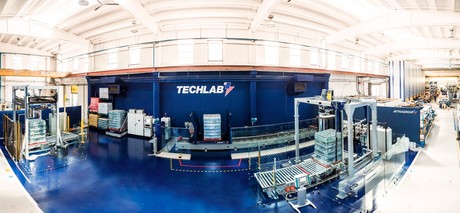Automated pallet wrapping for sustainable manufacturing

Research shows 82% of FMCG manufacturers are prioritising building sustainability into the supply chain. Are you one of them?
The first step in your fulfillment supply chain, stretch wrapping, is the process of securely wrapping the pallet with stretch wrap to protect and unitise the product, as well as to securely transport it through the supply chain. The stretch wrapping process can be manual, semi-automatic or fully-automatic.
In the case of manual pallet wrapping, the operator attaches the stretch wrap to a pallet load, he or she then goes around the load until the process of wrapping has been completed. It is time and labour resource intensive. Manual wrapping methods can at best achieve a stretch of 10 or 20%.
Sustainable manufacturing is all about being resource efficient. It can be about reducing costs by reducing the amount of materials from an input perspective or reducing the cost in terms of disposal costs without compromising the product quality. This is where automated pallet wrapping solutions can make an impact.
Automated pallet stretch wrapping solutions can pre-stretch the film from between 250% to 450%, saving you material, and money, by up to 55%. They also wrap without any operator intervention up to 130 pallets per hour so improve your efficiency and productivity. If you are using fewer resources and you have less waste, it’s going to cost you less.
Now the question is, can automated pallet wrapping solutions handle all load types?
The simple answer is, yes.
Types of stretch wrapping solutions
There are three main types of fully-automatic stretch wrapping solutions, with designs based on factors such as pallet size, pallet weight, pallet height, load type and load stability.
- Turntable: The pallet is placed on a turntable which spins the pallet load while it is stretch wrapped by a tower moving up and down to wrap the whole pallet. This method is most suitable for light to medium weight stable loads that do not get dislodged while spinning around on the turntable.
- Rotary arm: A specialised arm rotates around the pallet to wrap the load. This system requires a larger footprint and is best suited for heavy or unstable loads.
- Ring style: Similar to a rotary arm, with the film carriage arm being mounted to a ring that rotates around a load as it passes through the conveyor system. These systems are most useful in high-volume manufacturing lines, or for larger loads. They can also wrap multiple loads at a time.
The two key questions we get asked when customers are considering automatic pallet stretch wrapping solutions are:
- How do you ensure the pallet load is as stable as possible with the minimum amount of stretch film?
- How do you ensure our product arrives at our customer site in perfect condition?
The magic lies in getting the containment force right. This is the pressure holding the load together and is created by the number of revolutions of the stretch film multiplied by the tightness of the wrap called the wrap force. The minimum threshold level of containment force on a load determines its success. If the containment force is too low, the risk of an unsecure pallet is high.
There is a trade-off between the wrap force, layers of stretch wrap and throughput. Some testing is usually required to get the optimal solution to ensure an effective and efficient wrap pattern. Robopac and Foodmach offer a service to test pallet stability.
Efficient wrapping technology must ensure product stability while minimising the plastic stretch material used delivering a dual benefit of saving consumables and lower environmental impact to meet your sustainability goals.
Ultimately, fully automated stretch wrappers reduce the risk of injury and time needed to unitise each pallet load. They can improve product protection, maximise unitisation, and minimise packaging costs per load, including labour costs and stretch film costs. Perhaps most significantly, a correctly wrapped pallet reduces supply chain product damage that ultimately reduces product and packaging waste.
Foodmach has extensive experience with large food and beverage companies with end to end packaging line installations. They can help you improve your pallet stretch wrapping process with smart automated pallet wrapping solutions.
For more information visit www.foodmach.com.au or call 1800 FOODMACH (366 362).
Sweet Success: How Fishbowl helped Niche Bakers scale
As we settle into the new year, the NAB's recent research report reveals Australian SMEs have...
Level Up with Palletising
Do you need to increase your line efficiency? Palletising technology is a crucial driver of...
Craft Brewing Beacon of Success: Green Beacon's winning strategy with Fishbowl software, global deals, and CUB acquisition
At a time where the Australian craft brewing industry is struggling, Green Beacon Brewing Company...














